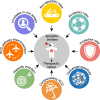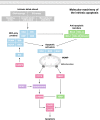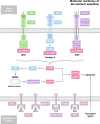Apoptotic cell death in disease-Current understanding of the NCCD 2023
- PMID: 37100955
- PMCID: PMC10130819
- DOI: 10.1038/s41418-023-01153-w
Apoptotic cell death in disease-Current understanding of the NCCD 2023
Abstract
Apoptosis is a form of regulated cell death (RCD) that involves proteases of the caspase family. Pharmacological and genetic strategies that experimentally inhibit or delay apoptosis in mammalian systems have elucidated the key contribution of this process not only to (post-)embryonic development and adult tissue homeostasis, but also to the etiology of multiple human disorders. Consistent with this notion, while defects in the molecular machinery for apoptotic cell death impair organismal development and promote oncogenesis, the unwarranted activation of apoptosis promotes cell loss and tissue damage in the context of various neurological, cardiovascular, renal, hepatic, infectious, neoplastic and inflammatory conditions. Here, the Nomenclature Committee on Cell Death (NCCD) gathered to critically summarize an abundant pre-clinical literature mechanistically linking the core apoptotic apparatus to organismal homeostasis in the context of disease.
© 2023. The Author(s), under exclusive licence to ADMC Associazione Differenziamento e Morte Cellulare.
Conflict of interest statement
All Editorial Board Members of Cell Death Differentiation, Cell Death Disease, or Cell Death Discovery are included among the authors. A. Degterev is shareholder in Denali Therapeutics. A. D. Garg has received renumeration, honorarium or consultancy fees from Boehringer Ingelheim, Miltenyi Biotec or IsoPlexis. A. Strasser and P. E. Czabotar (PEC) are employees of the Walter and Eliza Hall Institute, which has an agreement with Genentech and AbbVie and receives milestone and royalty payments related to venetoclax. Employees of the Walter and Eliza Hall Institute may be eligible for financial benefits related to these payments. PEC receives such a financial benefit as a result of previous research related to venetoclax. B. De Strooper (BDS) has no COI with the content of this paper. Possible perceived COI: BDS is or has been a consultant for Eli Lilly, Biogen, Janssen Pharmaceutica, Eisai, AbbVie and other companies. BDS is also a scientific founder of Augustine Therapeutics and a scientific founder and stockholder of Muna therapeutics. B. R. Stockwell is an inventor on patents and patent applications involving small molecule drug discovery, ferroptosis, and the antibody 3F3-FMA; co-founded and serves as a consultant to Exarta Therapeutics, and ProJenX Inc.; holds equity in Sonata Therapeutics, and serves as a consultant to Weatherwax Biotechnologies Corporation and Akin Gump Strauss Hauer & Feld LLP, and receives research funding from Sumitomo Dainippon Pharma Oncology. C. M. Troy has the following patent applications US20200164026, US20190142915, US20150165061, US20140024597. US2020058683, WO2018013519, WO/2020/223212. D. C. Rubinsztein serves as a consultant for Alladdin Healthcare Technologies Ltd., Mindrank AI, Nido Biosciences, Drishti Discoveries and PAQ Therapeutics. D. J. Murphy receives funding from the Merck Group (Darmstadt, Germany) & Puma Biotechnology (Los Angeles, CA, USA). D. Ofengeim is employed at SANOFI. JTO serves as a consultant for Anji Pharmaceuticals. J. T. Opferman receives research funding from AbbVie. D. W. Andrews receives funding for research in apoptosis from Amylyx. F Di Virgilio is Member of the Scientific Advisory Board (SAB) of Biosceptre Ltd (UK), and a consultant with Axxam SpA (Italy). F. Madeo has financial interest in TLL, The Longevity Labs and Samsara Therapeutics. P. Mehlen is founder and shareholder of NETRIS Pharma. G. A. Calin is the scientific founder of Ithax Pharmaceuticals. G. L. Kelly (GLK) is an employee of the Walter and Eliza Hall Institute which receives milestone and royalty payments related to venetoclax. GLK has received research funding from Servier. J. R. Cubillos-Ruiz is a scientific consultant for NextRNA Therapeutics, Inc. and Autoimmunity Biologic Solutions, Inc. K. Rajalingam is a founder and MD of KH Biotec GmbH. CVR is a scientific founder and member of the Scientific Advisory Board (SAB) of Surface Oncology, a member of Janssen Immunology SAB, and a consultant for the Roche Immunology Incubator. C. V. Rothlin has received grant support from Mirati Therapeutics. K. Schroder is a co-inventor on patent applications for NLRP3 inhibitors which have been licensed to Inflazome Ltd, a company headquartered in Dublin, Ireland. Inflazome is developing drugs that target the NLRP3 inflammasome to address unmet clinical needs in inflammatory disease. K. Schroder served on the Scientific Advisory Board of Inflazome in 2016–2017, and serves as a consultant to Quench Bio, USA and Novartis, Switzerland. L. Altucci receives funding for research from Merck and has shares in Epic SRL and CIRCE SRL. B. Joseph is cofounder of CERVO Therapeutics AB. M. Carbone received donations from the UH Foundation through donations from: the Riviera United-4-a Cure, the Melohn Family Endowment, the Honeywell International Inc., the Germaine Hope Brennan Foundation, and the Maurice and Joanna Sullivan Family Foundation. M. Carbone has a patent issued for BAP1. M. Carbone and two patents issued for HMGB1. M. Carbone is a board-certified pathologist who provides consultation for pleural pathology, including medical-legal. M. Conrad is a co-founder and shareholder of ROSCUE Therapeutics GmbH. M. Karin received support from Jansen Pharmaceuticals, Merck and Gossamer Bioscience. M. Karin is founder and member of SAB, Elgia Pharmaceuticals. M. Pagano is a scientific cofounder of SEED Therapeutics; receives research funding from and is a shareholder in Kymera Therapeutics; and is a consultant for, a member of the scientific advisory board of, and has financial interests in CullGen, SEED Therapeutics, Triana Biomedicines, and Umbra Therapeutics. M. G. Vander Heiden is a scientific advisor for Agios Pharmaceuticals, iTeos Therapeutics, Sage Therapeutics, Droia Ventures, and Auron Therapeutics. M. Oren is a consultant for Quintrigen. O. Kepp is a co-founder of Samsara Therapeutics. P. J. Jost has had a consulting or advisory role, received honoraria, research funding, and/or travel/accommodation expenses from: Ariad, Abbvie, Bayer, Boehringer, Novartis, Pfizer, Servier, Roche, BMS and Celgene, Pierre Fabre, Janssen/Johnson&Johnson, MSD. R. B. Damgaard is a scientific advisor for Immagene B.V., Amsterdam, Netherlands. R. I. Aqeilan serves as consultant for Mahzi Therapeutics. R. J. DeBerardinis is a founder and advisor at Atavistik Bio and serves on the Scientific Advisory Boards of Agios Pharmaceuticals, Vida Ventures, Droia Ventures and Nirogy Therapeutics. R. N. Ktsis is Co-founder of ASPIDA Therapeutics Inc. S. A. Lipton (SAL) discloses that he is the named inventor on worldwide patents for the use of memantine and derivatives for the treatment of neurodegenerative disorders. As per the rules of Harvard University, SAL participates in a Royalty Sharing Agreement with is former institutions, Boston Children’s Hospital/Harvard Medical School, which licensed these patents to Forest Laboratories and Allergan, now owned by Abbvie. SAL is also a founder of EuMentis Therapeutics, Inc., Adamas Pharmaceuticals, Inc. (now owned by Supernus Pharmaceuticals, Inc.), and a consultant to SNO bio, Inc., Engine Biosciences, Ventus Therapeutics, Inc., Eisai, inc., and Takeda Pharmaceuticals, Inc. S. Ghosh has received grant support from Mirati Therapeutics. S. J. Dixon is a co-founder of Prothegen Inc., and a scientific advisor to Ferro Therapeutics and Hillstream BioPharma. S. von Karstedt is named inventor on patent applications covering some of the therapeutic concepts pertaining to TRAIL-R blockade in disease. Y. H. Chen is a member of the board of advisors for Amshenn Inc. and Binde Inc. T.-D. Kanneganti is a consultant for Pfizer. T. Vanden Berghe and P. Vandenabeele hold patents related to ferrostatin-1 analogues. D. R. Green consults for Ventus Therapeutics, Inzen Therapeutics, and Horizon Therapeutics. K. H. Vousden is on the board of directors and shareholder of Bristol Myers Squibb and on the scientific advisory board (with stock options) of PMV Pharma, RAZE Therapeutics, Volastra Pharmaceuticals and Kovina Therapeutics. She is on the scientific advisory board of Ludwig Cancer and a co-founder and consultant of Faeth Therapeutics. She has been in receipt of research funding from Astex Pharmaceuticals and AstraZeneca and contributed to CRUK Cancer Research Technology filing of patent application WO/2017/144877. W. S. El-Deiry (WSE-D) is founder and shareholder (no research funding) of Oncoceutics/Chimerix, which is developing ONC201/TIC10 as cancer therapeutic. WSE-D is founder and shareholder (no research funding) of p53-Therapeutics, an early-stage company developing small molecules targeting mutant p53. WSE-D founder, and shareholder (no research funding) of SMURF-Therapeutics, an early-stage company developing small molecules targeting hypoxia. WSE-D is Co-Chair in the Executive Committee for Precision Oncology Alliance (no research funding) of Caris Life Sciences. WSE-D receives support from D&D Pharma and AACR-Novocure. WSE-D is the advisory board of Ocean Biomedical. WSE-D is the advisory board of RAIN Therapeutics. G. Kroemer has been holding research contra.cts with Daiichi Sankyo, Eleor, Kaleido, Lytix Pharma, PharmaMar, Osasuna Therapeutics, Samsara Therapeutics, Sanofi, Tollys, and Vascage. G. Kroemer has been consulting for Reithera. G. Kroemer is on the Board of Directors of the Bristol Myers Squibb Foundation France. G. Kroemer is a scientific co-founder of everImmune, Osasuna Therapeutics, Samsara Therapeutics and Therafast Bio. G. Kroemer is the inventor of patents covering therapeutic targeting of aging, cancer, cystic fibrosis and metabolic disorders. G. Kroemer’s brother, Romano Kroemer, was an employee of Sanofi and now consults for Boehringer-Ingelheim. L. Galluzzi is/has been holding research contracts with Lytix Biopharma, Promontory and Onxeo, has received consulting/advisory honoraria from Boehringer Ingelheim, AstraZeneca, OmniSEQ, Onxeo, The Longevity Labs, Inzen, Imvax, Sotio, Promontory, Noxopharm, EduCom, and the Luke Heller TECPR2 Foundation, and holds Promontory stock options. All other authors have no conflicts to declare.
Figures





References
Publication types
MeSH terms
Substances
Grants and funding
- 24399/CRUK_/Cancer Research UK/United Kingdom
- UL1 TR001863/TR/NCATS NIH HHS/United States
- R21 NS127076/NS/NINDS NIH HHS/United States
- R21 AG063012/AG/NIA NIH HHS/United States
- R01 AG056259/AG/NIA NIH HHS/United States
- R01 CA178394/CA/NCI NIH HHS/United States
- P30 CA008748/CA/NCI NIH HHS/United States
- R35 GM131689/GM/NIGMS NIH HHS/United States
- R01 CA238229/CA/NCI NIH HHS/United States
- R01 CA271346/CA/NCI NIH HHS/United States
- R01 AI114581/AI/NIAID NIH HHS/United States
- R37 CA248565/CA/NCI NIH HHS/United States
- R01 CA237264/CA/NCI NIH HHS/United States
- P01 AG031782/AG/NIA NIH HHS/United States
- R01 CA267696/CA/NCI NIH HHS/United States
- 15816/CRUK_/Cancer Research UK/United Kingdom
- R01 DK125263/DK/NIDDK NIH HHS/United States
- R35 AG071734/AG/NIA NIH HHS/United States
- R01 AI175004/AI/NIAID NIH HHS/United States
- R01 CA247941/CA/NCI NIH HHS/United States

